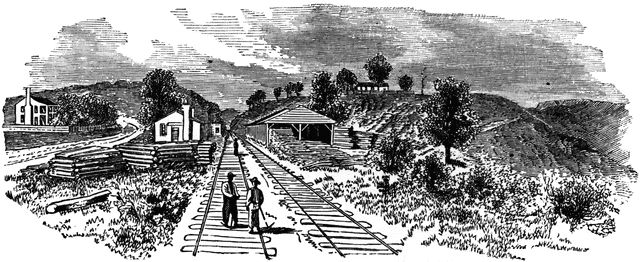
Benson John Lossing, ed. Harper’s Encyclopedia of United States History (vol. 1) (New York, NY: Harper and Brothers, 1912) Courtesy the private collection of Roy Winkelman
Today in the north Georgia mountains near Cartersville the Battle of Allatoona Pass takes place as the first major act in what becomes known as Confederate General John Bell Hood‘s Nashville Campaign, an offensive in north Georgia and central Tennessee designed to disrupt Union infrastructure and draw Sherman’s forces away from Atlanta.
Confederate forces, having spent the past two days destroying several miles of Union rails in order to disrupt the enemy’s supply lines into Atlanta, open an attack on Federal fortifications at Allatoona Pass at 10:30 in the morning. Their goal is to capture the Union storehouses there, within which large quantities of rations are packed away for use by the Union Army in Atlanta.
Aware that Sherman has ordered Union reinforcements to Allatoona Pass, the Rebels are forced to act quickly and decisively. Outnumbering their foe by about a three to two margin, the Confederates attack and force the Federals into the safety of Fort Star by 11 am.
During the following two and a half hours, the Confederates attack the heavily fortified structure four times, all to no avail.
Fearing the imminent arrival of Union reinforcements, commanding officer General Samuel French regretfully makes the decision to withdraw. As they retreat from the pass, the Rebels burn a Union blockhouse and take captive 89 Federals.
Thus begins the Nashville Campaign, the last major Confederate offensive of the war.
While the battle rages in north Georgia, far to the North the Philadelphia Baptist Association in session passes a resolution on the “State of the Country.” Pledging their “unswerving loyalty” to the United States government, the statement condemns the treasonous South and pledges to “crush the rebellion and restore the unity of the States.” Should the Confederacy perish, “their blood will be upon their own heads.”
As have countless northern Baptists previously, Philadelphia Baptists blame black slavery as the cause of the war:
“….slavery (never to be justified by the mild, temporary, patriarchal servitude of the Old Testament), the enormity and brutality of which has few parallels In the history of ages, lies at the basis of the wicked attempt to overthrow the Government, is responsible for the bloodshed and crime of the past three years, and should be held accountable before God and man for every life sacrificed and every drop of blood shed…no permanent peace, no lasting Union, and no public safety can be expected while slavery exists; and as an outlaw upon civilization, a pirate on human rights, the foe of God and man, alike the enemy of the white and black, it should be utterly, immediately, unconditionally and eternally blotted out, as one of the foulest stains that ever rested upon any civilized land…the only road to peace, and the only hope of Union, lie in the subjugation or the rebellion, the extermination of its cause, and the overthrow of its supporters; and therefore, until the necessity ceases, we should welcome taxation, sacrifice, and if needful, universal conscription— our motto being “First Christ’s, then our country’s!”
Northern and Southern Baptists have for nearly four years tirelessly traded bold yet contradictory proclamations of the will of God in regards to the black race. While the statements this month from both sides are as bold and certain as ever, the facts on the ground are clearly on the side of Northern Baptists.
The enslavement of blacks is evil, and the United States is on the verge of abolishing the peculiar institution that Southern whites are loath to relinquish.
Sources: Battle of Allatoona Pass (link) and (link) and (link); Edward McPherson, The Political History of the United States of America, During th Great Rebellion, Washington, D.C.: Philp and Solomons, 1865, p. 477 (link); image (link)


